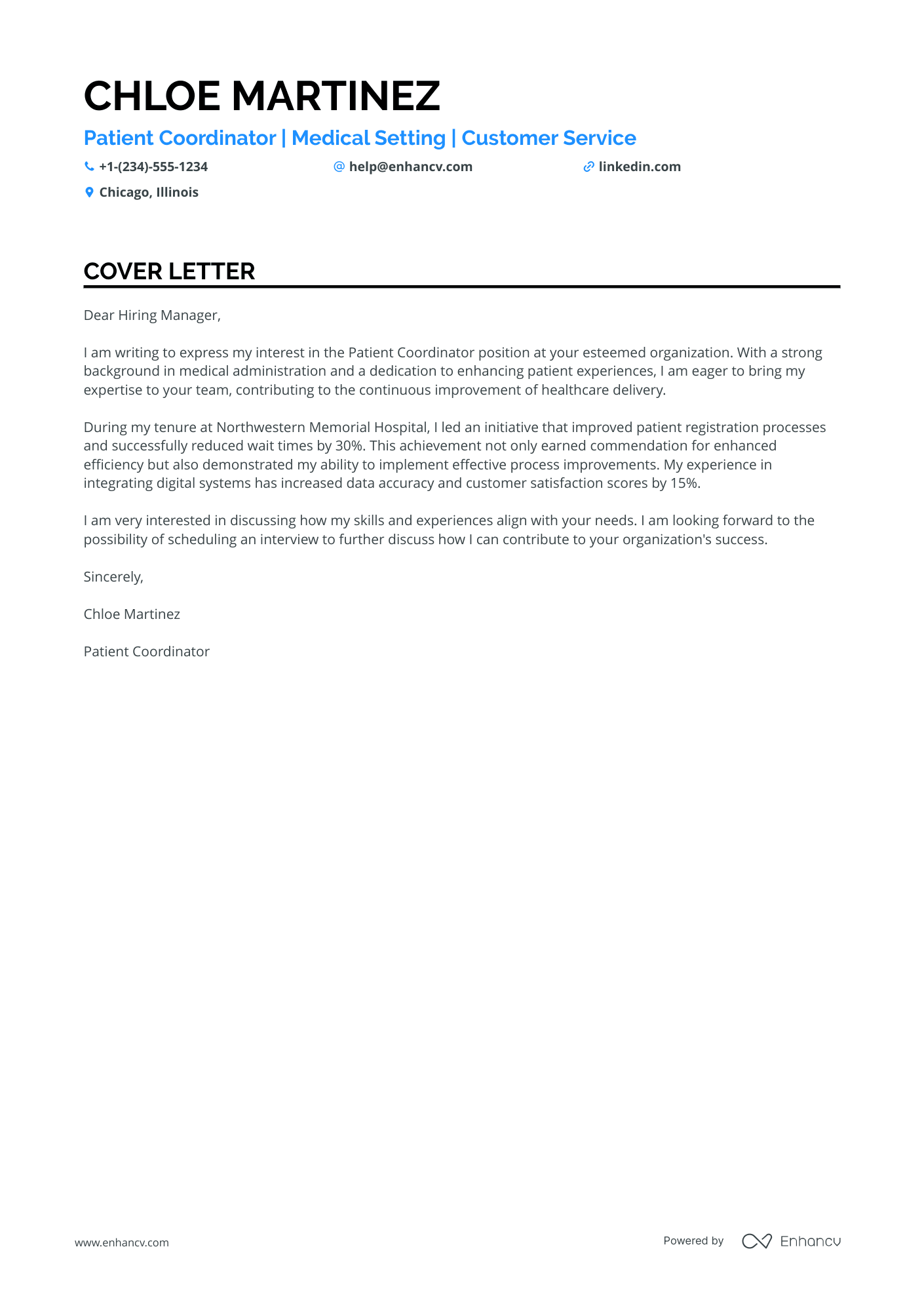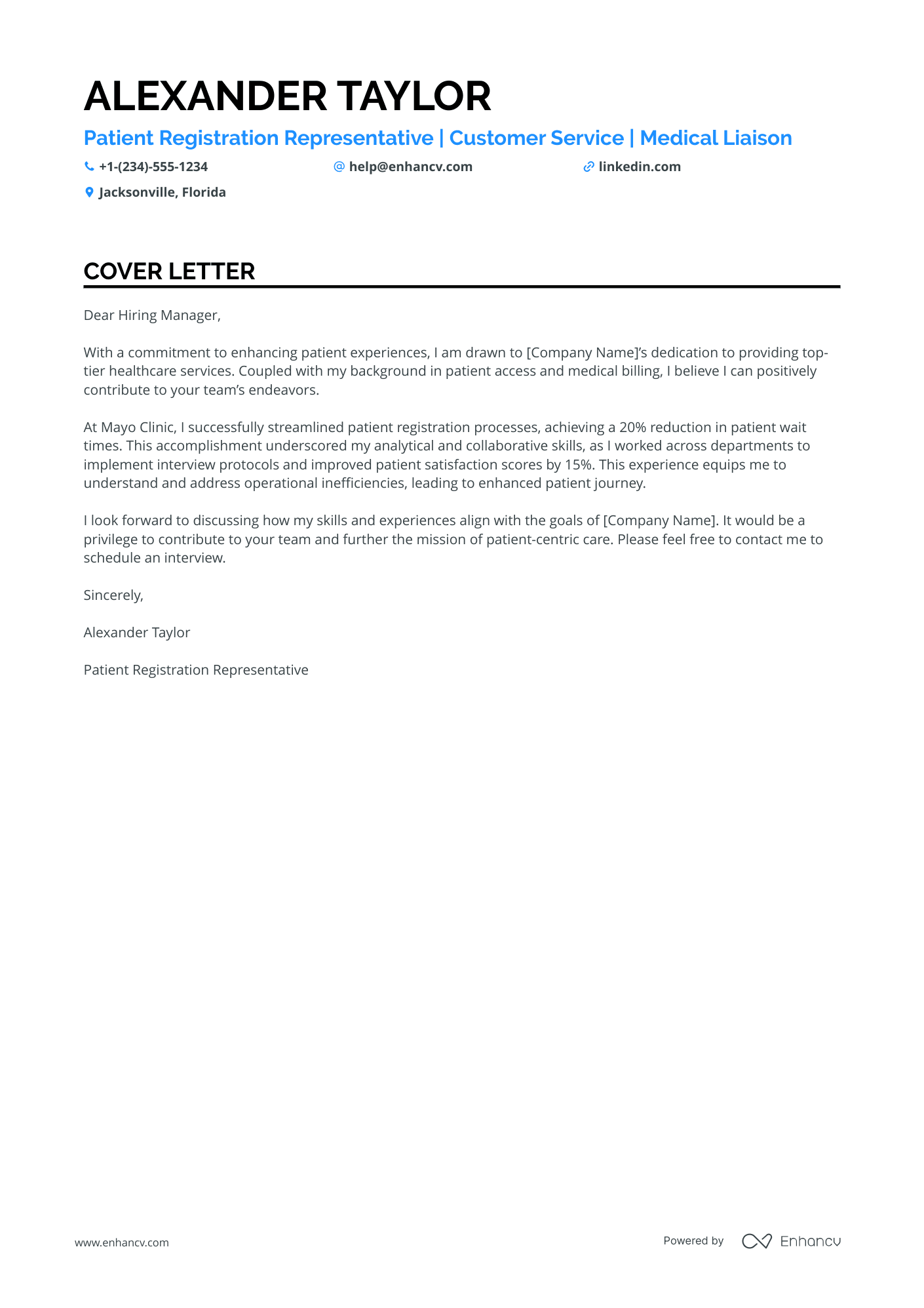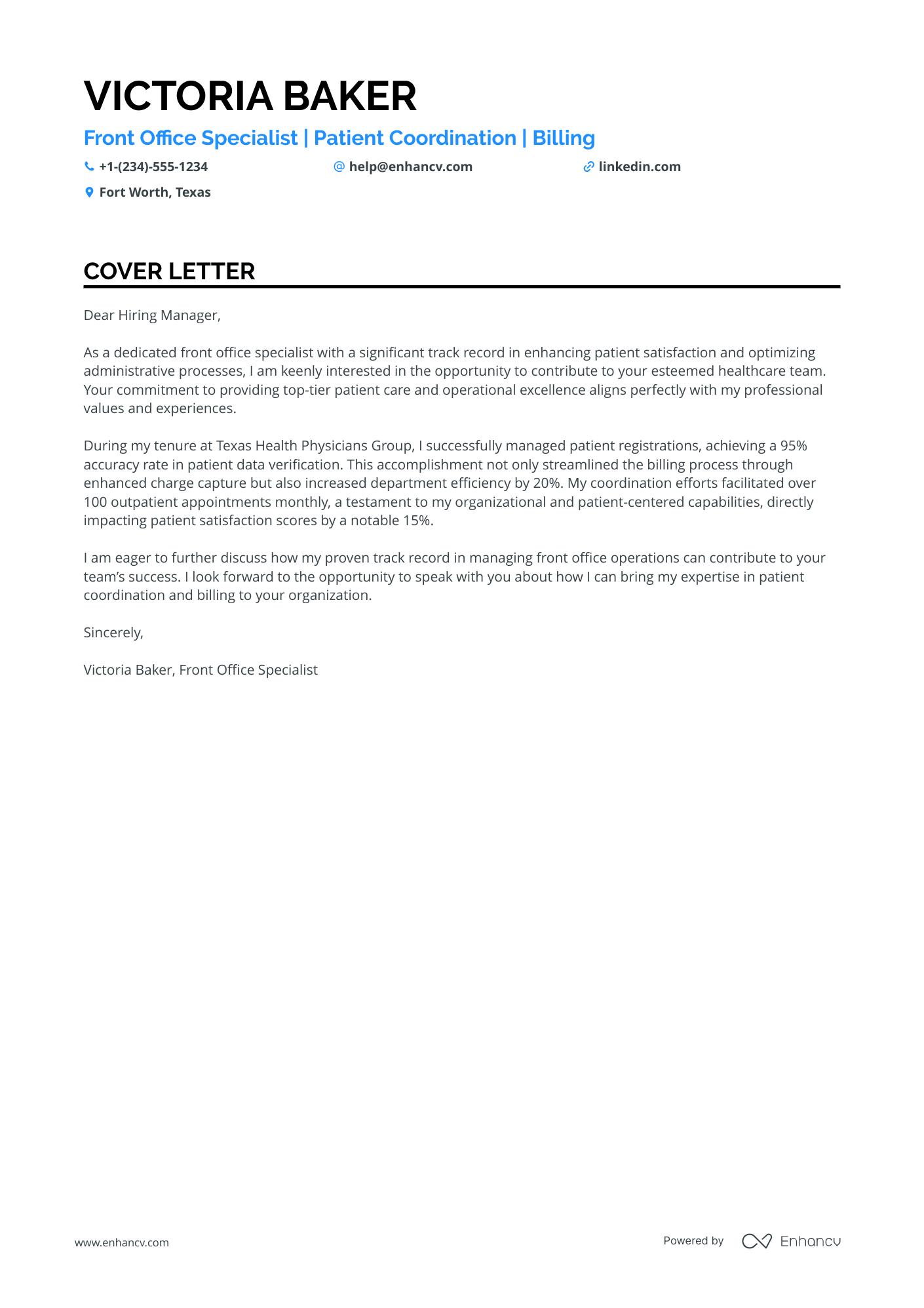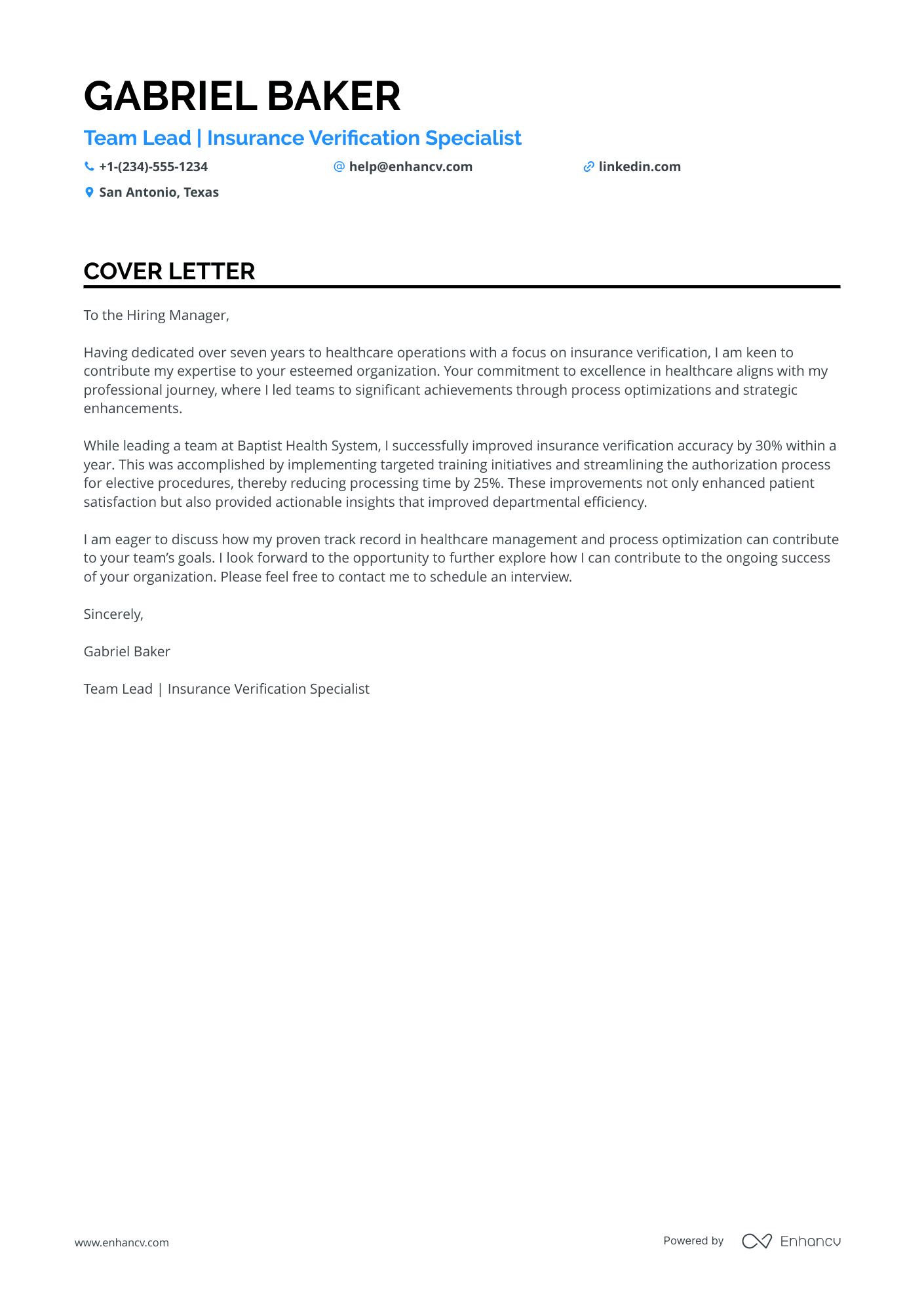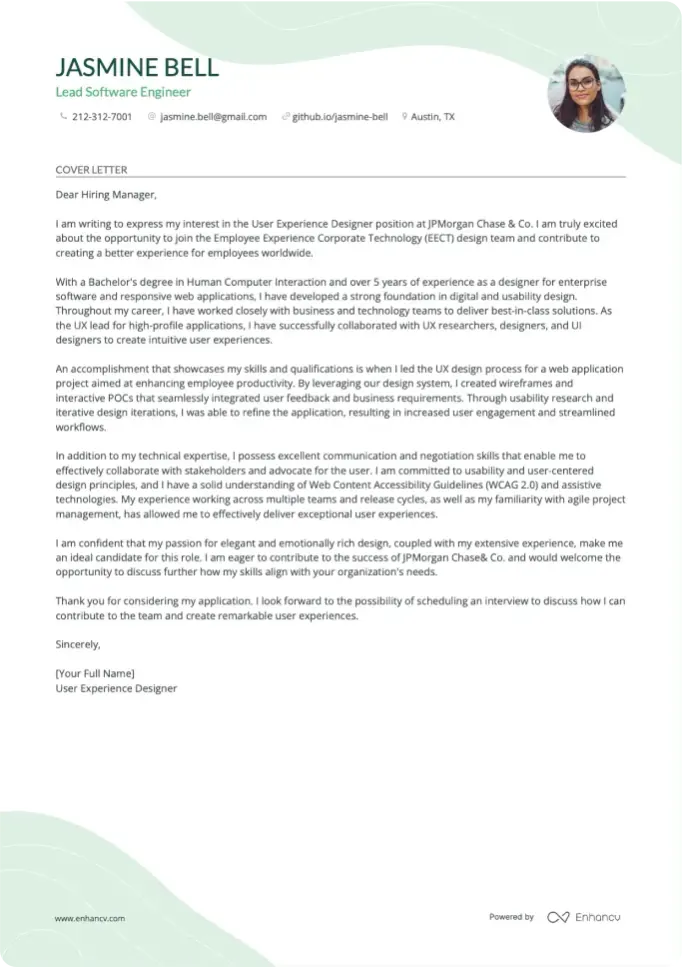Drafting a standout patient service representative cover letter can be a hurdle, especially if you've already hit the job application trail and realized it's not just another version of your resume. It should highlight a shining moment in your career, weaving your proudest achievement into a compelling narrative. This delicate balance of formality and personal touch cannot afford to trip over clichés, all while fitting neatly on a single page. Let's tackle this together, ensuring your cover letter reflects the best of you.
- Making excellent use of job-winning real-life professional cover letters;
- Writing the first paragraphs of your patient service representative cover letter to get attention and connect with the recruiters - immediately;
- Single out your most noteworthy achievement (even if it's outside your career);
- Get a better understanding of what you must include in your patient service representative cover letter to land the job.
Let the power of Enhancv's AI work for you: create your patient service representative cover letter by uploading your resume.
If the patient service representative isn't exactly the one you're looking for we have a plethora of cover letter examples for jobs like this one:
- Patient Service Representative resume guide and example
- Pediatric Medical Assistant cover letter example
- Social Work Student cover letter example
- Nurse Practitioner cover letter example
- Clinical Trial Manager cover letter example
- Pharmacy Technician cover letter example
- Associate Dentist cover letter example
- Expanded Functions Dental Assistant cover letter example
- Phlebotomist cover letter example
- Dental Assistant cover letter example
- Doctor cover letter example
Drop your resume here or choose a file.
PDF & DOCX only. Max 2MB file size.
Patient service representative cover letter example
Violet Rodriguez
Charlotte, North Carolina
+1-(234)-555-1234
help@enhancv.com
- Quantifiable Achievements: Mentioning a 30% increase in patient satisfaction and a 20% reduction in wait times showcases the ability to implement successful initiatives and create measurable outcomes, which is essential for a patient service coordinator role.
- Relevant Professional Experience: Highlighting experience with front desk operations and appointment scheduling demonstrates direct knowledge and skills that are highly valuable in healthcare administration and patient coordination.
- Alignment with Company Values: Referencing the company's dedication to patient-centered care and drawing parallels to one's own professional values and background helps to establish a cultural fit and a shared vision for improving patient care.
The visual appeal of your patient service representative cover letter: format, font, and structure
When using our cover letter builder, make sure to include these vital sections:
- Header (with your name, contact details, the role, and date);
- Greeting (that's personalized to the recruiter);
- Introductory paragraph (to capture attention);
- Body paragraph (to tell a story of how you've obtained your job-crucial skills);
- Closing paragraph (ending with a nod to the future ahead);
- Signature (that is not a must).
Our cover letter templates are already set up for you with the best patient service representative cover letter design with single-spaced paragraphs and a one-inch margin.
As for the font of your patient service representative cover letter, use the same one as you did in your resume (where modern and simple fonts, like Rubik and Bitter, take precedence over Arial and Times New Roman).
Your patient service representative cover letter is created with the recruiters in mind - as no Applicant Tracker System looks over this part of your profile.
When sending over your patient service representative cover letter, download it in PDF. This format allows your information and design to stay intact and to keep the same visual quality.
Not enough hours in the day? Try our free cover letter generator and get a polished letter in seconds.
The top sections on a patient service representative cover letter
Header with Contact Information: Include your name, address, phone number, and email address so the recruiter can easily reach you for an interview, and to convey a professional image fitting for a patient service representative who must handle personal information accurately.
Opening Greeting: Address the hiring manager by name if possible, as this demonstrates attention to detail and a personalized approach, both of which are valued in patient services roles where interaction with clients and colleagues is key.
Introduction Paragraph: Briefly introduce yourself and express your enthusiasm for the patient service representative position, highlighting your commitment to providing outstanding customer service and support within healthcare environments.
Experience and Skills Body Section: Outline your previous experience in healthcare or customer service settings and specific skills such as communication, scheduling, patient interaction, and problem-solving, which are crucial for a patient service representative to ensure efficient and compassionate care for patients.
Closing and Call to Action: Conclude by reiterating your interest in the role, expressing your eagerness to bring your skills to their team, and invite the hiring manager to contact you for a discussion, thereby showing your proactive approach which is necessary for managing patient needs effectively.
Key qualities recruiters search for in a candidate’s cover letter
- Excellent Communication Skills: Vital for interacting effectively with patients, healthcare professionals, and insurance companies.
- Empathy and Compassion: Essential for understanding and responding to the concerns and emotional states of patients.
- Experience with Medical Billing and Coding: Important for accurately processing patient charges and understanding insurance claims.
- Proficiency in Healthcare Software: Knowledge of electronic health records (EHR) systems and scheduling software to manage patient flow and documentation.
- Strong Organizational Abilities: Necessary for managing patient appointments, medical records, and ensuring smooth front-office operations.
- Problem-Solving Skills: Helpful for addressing and resolving patient service issues, billing discrepancies, and scheduling conflicts.
How to address hiring managers in your patient service representative cover letter greeting
Goodbye, "Dear Sir/Madam" or "To whom it may concern!"
The salutation of your patient service representative cover letter is how you kick off your professional communication with the hiring managers.
And you want it to start off a bit more personalized and tailored, to catch the recruiters' attention.
Take the time to find out who's recruiting for the role (via LinkedIn or the company page).
If you have previously chatted or emailed the hiring managers, address them on a first or last name basis.
The alternative is a "Dear HR team" or "Dear Hiring Manger", but remember that a "Dear Ms. Simmons" or "Dear Simon," could get you farther ahead than an impersonal greeting.
List of salutations you can use
- Dear Hiring Manager,
- Dear [Name of the Hiring Manager],
- Dear Mr./Ms. [Last Name],
- Dear Members of the [Department Name] Team,
- Dear [Department] Hiring Committee,
- Dear Dr. [Last Name], (if the person holds a doctorate)
Get creative with your patient service representative cover letter introduction
Recruiters are going to assess plenty of candidate profiles for the role. Thus, anything you do to stand out will win you brownie points.
Use your patient service representative cover letter introduction to share something memorable about your experience.
But before you go down the rabbit hole of creativity and humor, align your message with the company culture.
For example, if you are applying for a role in some startup, use those first two sentences to tell a funny story (about your experience) to quickly connect with the recruiter.
Storytelling in the middle (or body) of your patient service representative cover letter
You've got your whole resume sorted, detailing your achievements and skills. What else can you write in your patient service representative cover letter?
For starters, take the time to re-assess the job requirements and re-discover the most crucial skills and requirements (or keywords).
After making a list of these important keywords, look back on your experience to select just one of your past accomplishments.
Choose the achievement that is the most noteworthy, relevant to the role, and matches the required skills.
Use the next between three and six paragraphs to narrate how:
- you've grown your skill set, thanks to your achievement;
- you'd use the know-how you've gained in your new role;
- your accomplishment could help your potential employers grow.
Remember that recruiters don't need a retelling of your whole resume, but want to find out what makes you, you.
Two ideas on how to end the final paragraph of your patient service representative cover letter
Closing your patient service representative cover letter, you want to leave a memorable impression on recruiters, that you're a responsible professional.
End your cover letter with how you envision your growth, as part of the company. Make realistic promises on what you plan to achieve, potentially, in the next six months to a year.
Before your signature, you could also signal hiring managers that you're available for the next steps. Or, a follow-up call, during which you could further clarify your experience or professional value.
Is it beneficial to mention that you have no experience in your patient service representative cover letter?
Just be honest that you may not have had roles in the industry, but bring about so much more.
Like, your transferable skills, attained thanks to your whole work and life experience (e.g. the skills your summer spent working abroad taught you).
Or, focus on what makes you, you, and that one past success that can help you stand out and impress recruiters (think of awards you've attained and how they've helped you become a better professional).
Alternatively, write about your passion and drive to land the job and the unique skill set you would bring to enhance the workplace culture.
Key takeaways
Winning at your job application game starts with a clear and concise patient service representative cover letter that:
- Has single-spaced paragraphs, is wrapped in a one-inch margin, and uses the same font as the patient service representative resume;
- Is personalized to the recruiter (using their name in the greeting) and the role (focusing on your one key achievement that answers job requirements);
- Includes an introduction that helps you stand out and show what value you'd bring to the company;
- Substitutes your lack of experience with an outside-of-work success, that has taught you valuable skills;
- Ends with a call for follow-up or hints at how you'd improve the organization, team, or role.
Patient Service Representative cover letter examples
By Experience
Senior Patient Service Representative
- Emphasize proven track record: Highlight specific achievements, such as the initiative to reduce patient wait times by 30%, demonstrating effectiveness in improving administrative processes.
- Showcase relevant experience: Discuss previous roles that involved critical skills for the Patient Coordinator position, such as patient registration and process improvements.
- Focus on impact: Mention quantifiable outcomes, like increasing data accuracy and customer satisfaction by 15%, to underscore the tangible benefits brought to previous positions.
- Express a proactive attitude: Display eagerness to contribute to the organization’s success and openness to discussing how personal expertise aligns with organizational needs.
Patient Service Representative I
- Highlight specific accomplishments that demonstrate relevant skills, such as reducing patient wait times and improving patient satisfaction scores.
- Emphasize teamwork and collaboration by showcasing past experiences working across departments to achieve goals.
- Express genuine interest in the company's mission or unique aspects of its service, aligning personal values with the organization’s objectives.
Junior Patient Service Representative
- Emphasizing Results: The cover letter effectively details specific achievements, such as managing patient registrations with a 95% accuracy rate and increasing department efficiency by 20%, which are crucial for roles that impact patient care and administrative efficiency.
- Quantifying Contributions: Highlighting a quantifiable improvement, such as a 15% increase in patient satisfaction scores, provides concrete evidence of the candidate's positive impact on the organization.
- Alignment with Employer's Values: The letter expresses a clear alignment with the employer's goals, like enhancing patient satisfaction and operational excellence, which can resonate strongly with hiring teams looking for mission-driven professionals.
Lead Patient Service Representative
- Quantifiable Achievements: Emphasize measurable accomplishments like improving verification accuracy by 30% and reducing processing time by 25%, showcasing a direct impact on departmental efficiency.
- Leadership and Process Improvement: Highlight leadership experience and process optimization skills which are crucial for roles in healthcare operations, especially in managing teams and refining systems.
- Alignment with the Organization: Reflect a clear understanding of and alignment with the organization's goals, demonstrating the candidate's motivation and potential cultural fit.
- Invitation for Further Discussion: End with a proactive invitation for an interview, indicating enthusiasm and eagerness to contribute further.
